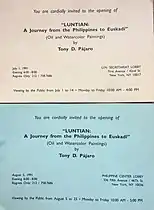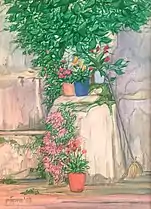Tony D. Pájaro | |
|---|---|
 Tony D. Pájaro | |
| Born | Antonio Diestro Pájaro December 1948 Manila, Philippines |
| Nationality | Spanish |
| Occupation | Painting |
Antonio "Tony" Diestro Pájaro (born 1948) is a painter from the Philippines. Born in Manila, he studied Fine Arts and then took complementary courses in the University of the Philippines (1970), in the University of Bilbao (1972, 1981), in the University of the Basque Country (1983), and also researched the art and culture of the Philippine tribes Ifugao, Hanunoo, B'Iaan and T'Boli (1988).[1]
The UNESCO awarded him the "Honorary Diploma in Painting" in 1975.
Biography
Born in Manila, he is the son of Victor Pájaro and Claudia Diestro. He began his artistic career in the Philippines, but later went on to study in Japan and in Europe.In 1971 he held complementary courses at the Philippine Art Educators Association in Manila. Later in 1981 he studied Child Art at the University of Bilbao and at the University of the Basque Country / Euskal Herriko Unibertsitatea.
He taught art in Manila (1970-1975), in Tokyo (1975-1976), and in San Sebastián (1976-2000, 2005).[2] Since then he was the director of the children's workshop "Art Club" in San Sebastian.[3] In 2006 he was one of the people who vindicated the cultural value of the Soroborda and Buskando water tanks built in the 19th century in San Sebastian when a real estate operation threatened to demolish them.[4]
He was a contributor to the Philippine Graphic Magazine and The Philippine Daily Inquirer (1997-2002). In 2020 he took part in the Art Collector's Guide association in the Philippines.
In 1995 he was responsible for the summer course Plastic Expression organised by SOS Balkanes Gipuzkoa in refugee camps in Croatia, and Bosnia and Herzegovina.
 He researched on the art and culture of Ifugao.
He researched on the art and culture of Ifugao..jpg.webp) Ifugao, 1988
Ifugao, 1988.jpg.webp) Mangyan 1988
Mangyan 1988.jpg.webp) 1983
1983.jpg.webp) San Sebastián, 1991
San Sebastián, 1991
Work
He organised 26 exhibitions, for example in the following cities: Manila,[5] Tokyo, San Sebastián,[6][7] Pamplona, Zumárraga, Irura, Lasarte, Hernialde, Belauntza, Getafe, Nueva York, Las Vegas, Michigan, Chicago, California, Madrid, Barcelona, and Hendaye.
His first exhibition was organised in Manila in 1971.
The 1975 exhibition in Manila entitled "DAROYPAJARO" was organised jointly with paintings by Tony Daroy and Tony Pájaro at the Hyatt-Regency Hotel.
The 1991 exhibition in New York entitled "LUNTIAN: A Journey from the Philippines to Euskadi" was held at the United Nations Lobby in Manhattan for the first two weeks of July, and then continued for three weeks of the following month at the Philippine Center.
In 1998 he exhibited Philippine and Basque landscapes at the headquarters of the Colegio de Peritos e Ingenieros de Guipuzkoa in San Sebastian, and later also at the Sala de Exposiciones. Later, also in Donostia-San Sebastian, in November 2004 he exhibited at the Sala Kutxa-Boulevard of the Caja de Ahorros Provincial de Guipuzkoa with landscapes of Cebu in the Philippines and of the municipal nurseries in Ulía, a neighbourhood of Donostia-San Sebastian.
He has also organised exhibitions in Portugal and France. Some of his paintings were auctioned in Las Vegas (Nevada). He has painted several pictures commissioned by some Guipuzcoan municipalities. (Belauntza, Hernialde, Zumarraga) and in Philippines too (Mandaluyong).
 First exhibition (Manila 1971)
First exhibition (Manila 1971).jpg.webp) Exhibition in 1975
Exhibition in 1975 Needed home (Tokyo, 1976)
Needed home (Tokyo, 1976) Manhattan, 1991
Manhattan, 1991 Huerto de la familia (Soroborda, San Sebastián, 1996)
Huerto de la familia (Soroborda, San Sebastián, 1996)
Distinctions
- 1975: "Diploma of Honorary in Painting" UNESCO. Tokyo
- 1991: recipient Regional Council of Gipuzkoa Grant for artistic creation in painting.
- 1991: United Nations Exhibit. New York
- 1991: Philippine Center Exhibit. New York
- 1996; Grant for creation in painting from the Municipal Government of Mandaluyong in the Philippines.
References
- ↑ "Exposición de pintura // Painting exhibition (Tony Pájaro) // Pintura-erakusketa: Tony Pájaro". Uliako Auzo elkartea /Ulía Neighbourhood Association. Uliako Auzo elkartea //Ulía Neighbourhood Association. Retrieved 15 August 2021.
- ↑ ""Tony Pájaro filipinarraren margoak ikusgai daude Donostian" "The paintings of the Philippine Tony Pájaro are exposed in Donostia"". Berria. Euskaldunon Egunkariaren hemeroteka / Digital Library of Euskaldunon Egunkaria. 1998-12-24. Retrieved 26 August 2021.
- ↑ Journal Intxaurrondo Primera Página (13 August 2021). "Tony Pájaro, director of Montessori Art Club in San Sebastián (Journal Intxaurrondo Primera Página, 1991-03-01) Larrotxene Kultur Etxea". Larrotxene Kultur Etxea. Retrieved 26 August 2021.
- ↑ Peña, Aletxu (2006-10-05). "Tesoros ocultos en la falda del monte Ulía" (PDF). Diario Vasco. Retrieved 26 August 2021.
- ↑ "Final Exhibit Day". The Manila Times. 1971-11-11. Retrieved 26 August 2021.
- ↑ Estrada, Gorka. "Tony Pájaro pinta los viveros de Ulia". www.noticiasdegipuzkoa.eus (in Spanish). Noticias de Gipuzkoa. Retrieved 26 August 2021.
- ↑ ""Tony Pájaro filipinarraren margoak ikusgai daude Donostian" "The paintings of the Philippine Tony Pájaro are exposed in Donostia"". Berria. Euskaldunon Egunkariaren hemeroteka / Digital Library of Euskaldunon Egunkaria. 1998-12-24. Retrieved 26 August 2021.